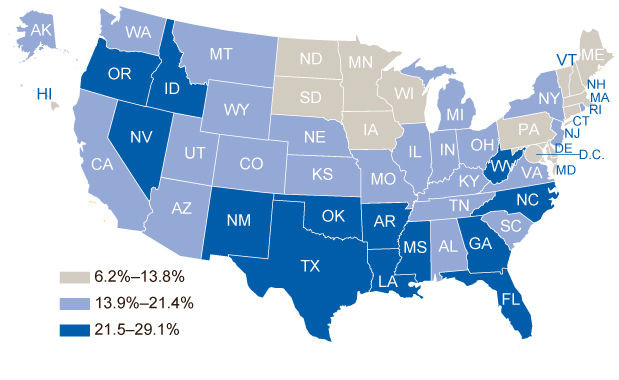 CLICK HERE. / " title="RHODE ISLAND HAS the highest percentage of uninsured adults in New England, according to data released by the CDC. For a larger version of this image, CLICK HERE. /"/>
CLICK HERE. / " title="RHODE ISLAND HAS the highest percentage of uninsured adults in New England, according to data released by the CDC. For a larger version of this image, CLICK HERE. /"/>ATLANTA – Rhode Island has the highest percentage of uninsured adults in New England, according to the 2009 Behavioral Risk Factor Surveillance System released by the Centers for Disease Control and Prevention.
The agency released a map of uninsured adults in its Vital Signs’ Access to Health Care report this week, noting that new 2010 estimates “show that the number of Americans without health insurance is growing, affecting middle-income Americans as well as those living in poverty.”
About 50 million adults – between the ages of 18 and 64 – had no health insurance for some part of the past 12 months while about 30 million had gone even longer without coverage. On average, 1.1 million more adults go without health care each year, the CDC said, noting about half were in the “middle-income” range ($43,000 to $65,000 for a household of four).
The CDC noted that the uninsured are more likely to skip medical care based on cost concerns which can lead to poorer health, higher long-term health care costs and early death.
Rhode Island’s percentage of uninsured adults registers in the 13.9 percent to 21.4 percent range while the rest of New England sees a rate between 6.2 percent and 13.8 percent. Regionally, New York and New Jersey had similar rates to the Ocean State.
Massachusetts, with its strong state policies on coverage, noted 6 percent of its residents were uninsured, while Texas had one of the highest rates in the country at 29 percent.
More than 40 percent of uninsured adults who had high blood pressure, asthma or diabetes reported they had skipped care because of costs in 2009.
Thirteen of the 50 states were in the highest range on the CDC’s map, between 21.5 percent and 29.1 percent.
The CDC noted that the Affordable Care Act is projected to extend health insurance for up to 94 percent of people by 2019.
For more information, click here.













Lack of insurance may not mean lack of care — although the health insurance promoters want us all to believe this, and never cite any info or data on those who choose to not buy health insurance. Who would that be? Healthy adults who do NOT have any chronic illnesses (mostly because they eat right and stay fit – I’m not talking genetic factors here) and who choose not to buy insurance other than catastrophic care — that is, with a deductible of $5K, $10K, or whatever one wants. When monthly premiums cost $350 – $500 for an individual, it’s pretty easy to save that money instead — and make one’s OWN decisions about the health care one wants or needs – rather than leaving it to someone in an insurance company who does NOT have a medical degree.
Let’s be real. There was no health insurance when many of us were kids, and health care was in many ways better THEN. The first example that comes to mind? There was no issue with infection-resistant antibiotics — because people didn’t run to the doctor every time they or their kids got sick — and demand an instant cure.
In addition, the US does not practice evidence-based medicine. In the past year, the NY Times has had several articles on this issue. Here’s one: doctors in Europe stopped prescribing/installing certain knee and hip replacement appliances after just a few months on the market, after their patients experienced ongoing pain and infection that required new surgery and removal/replacement. They have a system that tracks the use and efficacy of such appliances. Meanwhile, the US has continued to use them – if not any longer (given the article), then for years after European doctors stopped. Another example: people who were candidates for knee surgery were offered intensive physical therapy for an extended period (far more than what would generally be paid for by health insurers) in place of knee replacement. Guess what? The ones who had PT versus knee replacement surgery did BETTER overall in terms of experiencing/managing pain, flexibility, knee strength/use, etc. So why isn’t PT recommended by doctors and paid for by our insurance industry – versus expensive, painful, and not always effective surgery?
I’d guess it’s because we also have a system that is driven by profit. National studies have found that as much as 30% of our health care dollars go to pay “administrative overhead”. That’s the salaries of the health insurance industry, and of high-priced hospital CEOs — and $$ that is redirected from YOUR health care and your doctor’s wallet for providing it to you.
And Democrats wonder how Obamacare helped bring them down? Single payer was the only rational option. Even then, the costs will continue to drain the middle class. Can anyone explain to me how I should pay high health insurance costs for US citizens who now are reported to eat 1 out of every 7 meals at McDonalds? Did anyone see “Supersize Me?” Hello? It’s NOT going to happen!